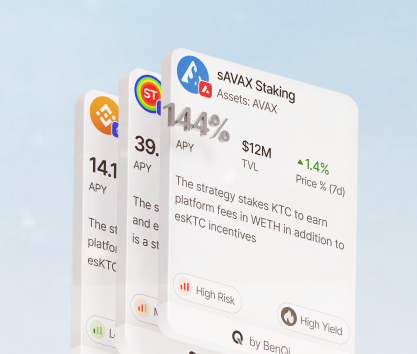Ethereum is the biggest blockchain in terms of active users, developers, Dapp deployment, and many other metrics. The switch to the PoS mechanism enabled a whole swath of new investment projects that took advantage of the staking process and the rewards that can be earned through it.
One of the biggest issues of all layer 1 networks, including Ethereum, is throughput and general performance. Scalability is an unsolved problem. However, layer-2 networks are capable of addressing some of the issues of the underlying technology. Among many interesting platforms in this category, Arbitrum stands out as a growing ecosystem with several exciting products!
The Arbitrum DeFi Ecosystem
In its marketing materials, the chain positions itself as the future of Ethereum. The flagship solution is the Nitro Stack which improves throughput and performance with the Rollup version and upholds high security standards with AnyTrust. One of the biggest advantages for developers is the ability to write and deploy Dapps using their favorite languages. Through the Stylus system, it is possible to code applications in Rust, C, or C+ and make sure that they are fully compatible with the Ethereum Virtual Machine.
Thanks to its versatility, the network quickly attracted users and can brag about some respectable numbers:
- According to the development team, Arbitrum managed to save 3.02 million ETH through its rollup program and other useful features allowing it to significantly cut costs.
- In August 2024, the number of active wallet addresses surpassed 1.53 million. During the last three years, the share of DeFi users grew too.
- Investors trust the platform with over $16.6 billion in total value locked across all protocols deployed on Arbitrum. This number allows the network to capture a 40% market share.
The chain has successfully served and settled 1.17 billion transactions throughout its history. It is one of the most frequently used layer-2 infrastructures in the Ethereum ecosystem.
Yield farming on Arbitrum
The network is created to facilitate the growth of the DeFi ecosystem and relies heavily on various investment products released by the community. Arbitrum supports several yield-generating protocols including Aave, GMX, Gains Network, Uniswap, and Pendle. The versatility of the network allows investors to build sophisticated portfolios with complicated compositions while managing risks and avoiding losses.
Among the most successful projects deployed directly on the network, decentralized exchanges have the biggest share. Some of the most recognized brands in this category are Balancer and Curve. You can find a variety of lending platforms, DeFi analytical tools, and more. Arbitrum’s catalog of deployed projects is massive and features several hundred decentralized finance applications alongside solutions for gaming, non-fungible token minting, and bridges.
Arbitrum farming strategies
Experienced investors can take full advantage of the diverse suite of investment options available to Arbitrum users. Since the chain has popular projects in all DeFi categories, including DEXes, derivatives, lending, staking, and more, you will be able to construct a flexible strategy that allows you to quickly react to changing market conditions.
Whether you are interested in chasing the biggest APY number or want to use a conservative system focused on loss aversion, you will find adequate tools among Dapps deployed on Arbitrum. For instance, GMX offers up to 30% APY on the SOL-USDC pair with 10% base APY. On the other side of the spectrum, locking USDT on Compound will give you 2.49% base APY and 0.55% in COMP rewards.
Below are some strategies that you can use with instruments available on Arbitrum:
- Hedging market positions. Staking ETH seems like an incredibly safe endeavor given the general positive market dynamics and long-term gains experienced by early adopters. However, price fluctuations are still quite massive with average volatility in 2023 reaching 14%. Hedging against market risks is possible with derivatives like futures allowing retail traders to short-sell ETH or any other asset used in the perpetual futures market. IPOR is an interesting choice from this category as it offers interest rate derivatives with all the necessary conditions determined and offered by the automatic market-maker.
- Use powerful yield aggregators. Contemporary investors have access to a wide selection of tools including specialized protocols that gather on-chain data, analyze yields, automatically reinvest rewards, and select the best route for capital allocation. Among some of the most interesting solutions deployed on Arbitrum are Beefy Finance and Yearn Finance. The former is a great project supporting a variety of pools created by native protocols and has a sizeable $93 million TVL. The latter supports 6 chains and has a less impressive $12.7 million TVL.
- Engage in high-APY, low-cost yield farming. Arbitrum is known for its speculative projects that carry a high level of risk but promise huge returns in exchange. While we cannot recommend using these protocols if you want to create a consistently performing portfolio, some investors who want to focus on short-term gains may be interested in high-risk and high-reward yield farming options. For instance, Camelot has a WETH-GMX pair pool with a 515% base APY and 81% 30-day average. Multiposition Camelot pool from Steer Protocol pays 323% mixed APY on WETH-USD+.
These strategies can be viable and generate massive returns. However, one must remember about certain caveats and risks when using DeFi protocols promising high yields. For example, Camelot is paying its users with GRAIL, its native token. The inherent inflationary nature of reward tokens is not an issue here since experienced investors should take potential price depreciation into consideration. The problem is that up to 80% of rewards are locked for 6 months making the payout way less attractive.
Maximize yield on Arbitrum
Many investors come to this blockchain chasing high interest rates which can be incredibly enticing. Unlike Solana or Base, Arbitrum as a chain does not have the reputation for hosting too many memecoins, rug pulls, and other questionable projects. However, it does not mean that the network is free of Dapps designed with malicious intent.
When trying to find the best way to allocate capital to DeFi protocols deployed on this network, remember about DYOR!
Below are several examples of high-yield pools with an explanation of how they achieve incredibly big numbers:
- Camelot offers 17% fluctuating APY on WETH-SPOOL investments. This number is achieved by not paying a mixed APY. All earnings are in GRAIL rewards that must be locked for at least 6 months before you can cash out.
- Ramses CL has a 370% reward APY on the WETH-USDT pool, but with RAM prices losing 650% of their value since launch, you can see how these numbers don’t really make sense for a long-term investor. Low trading volumes also should be considered. You may very well never sell RAM for a reasonable price.
- Hyperliquid has some crazy vaults which are designed to be the alternative to copy trading where contributors simply follow the operations conducted by the vault’s operator. For instance, the Elsewhere vault has been active for 50 days generating 3,260% APR. The problem is that these instruments are, at best, highly speculative investments. The vast majority of pools were lost to market volatility.
When it comes to selecting appropriate DeFi strategies on Arbitrum, investors must be aware of the nuances associated with tools offered by Dapps on this blockchain. In some cases, you will be able to quickly increase your holdings and successfully cash out. In others, you will be stuck with worthless native tokens that do not even have sufficient trading volumes to be liquidated at a loss.
The good thing is that the network has instruments allowing you to hedge against various risks by either playing on interest rates on IPOR or using perpetual futures on Gains Network or Hyperliquid.
The sheer scale of this chain provides ample space for Dapps to grow. The combined TVL of Arbitrum’s yield farming protocols focused strictly on liquidity pools is close to $474 million. In total, the number of tracked projects is 77. Analyzing all of them is quite challenging and, honestly, useless since only 19 of them have TVL larger than $1 million as of the time of writing. Instead, we will focus on several protocols that look like the most effective choices overall and based on rewards you can earn.
Arbitrum liquidity pools
Some protocols are designed to invest in liquidity pools to generate returns. Others are for specific products like perpetual futures. Finding the right project can be challenging with the sheer number of available options on this network. However, several interesting protocols stand out from the crowd by attracting more investors and providing good interest rates.
Here are some great destinations for users who want to make money on yield farming:
- Pendle has several specialized products for participation in LPs. For example, the GUSD pool currently available to investors has a TVL close to $14.3 million and pays a 10.26% base APY on top of 7.4% in PENDLE rewards. In total, the project has $231 million in total value locked.
- The Magpie ecosystem is an interesting destination for investors interested in receiving good rewards in native tokens. The MWOMSV pool offers up to 147% in MGP rewards and has a 114% 30-day average. Note that you can invest in other blockchains and DEXes using this ecosystem. Arbitrum is just a tiny part.
- Aura is a highly specialized pool that works with staked ETH and wrapped ETH. The total value locked across Arbitrum pools is $30 million. Some of the best pools are WSTETH paying up to 26.4% in AURA and ARB rewards.
Arbitrum farming rewards
If you are interested in high-yield offerings in the ecosystem, we will give you a list of interesting options. However, be aware of elevated risks and the questionable nature of some pools that may never bring in the profits you are chasing.
Here are the highest APYs you can get on Arbitrum:
- WETH-USD+ on Pancakeswap has a 94% base APY and 405% in rewards. The 30-day average is 2,236% APY (August 2024) boosted by a single day of incredibly high returns.
- WETH-ARB on Merkl is a good choice if you are looking for a nice chunk of farming rewards. You will be awarded ARB at a very high 103% annualized rate. The pool has over $7.4 million in TVL.
- ARB-USDC on Camelot V3 pays a pase APY of 81.73% with the 30-day average reaching 176% in August 2024. The TVL is over $1 million.
The dangers of Arbitrum yield farming
While this network is not notoriously frivolous with its projects and does not have the same number of spectacularly failing projects as Solana, it is still a place where speculative protocols thrive and often attract inexperienced investors who do not know better. We strongly suggest learning as much as possible about this blockchain and its projects. You may find a diamond or be warned about a piece of coal which is also made of carbon.









